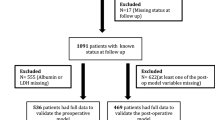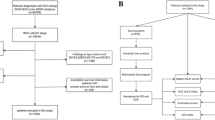Abstract
Purpose
Based on data retrieved from a comprehensive multicenter database, we externally validated a published postoperative nomogram for the prediction of disease-specific survival (DSS) in patients with papillary renal cell carcinoma (papRCC).
Methods
A multicenter database containing data of 2325 patients with surgically treated papRCC was used as validation cohort. After exclusion of patients with missing data and patients included in the development cohort, 1372 patients were included in the final analysis. DSS-probabilities according to the nomogram were calculated and compared to actual DSS-probabilities. Subsequently, calibration plots and decision curve analyses were applied.
Results
The median follow-up was 38 months (IQR 11.8–80.7). Median DSS was not reached. The c-index of the nomogram was 0.71 (95% CI 0.60–0.83). A sensitivity analysis including only patients operated after 1998 delivered a c-index of 0.84 (95% CI 0.77–0.92). Calibration plots showed slight underestimation of nomogram-predicted DSS in probability ranges below 90%: median nomogram-predicted 5-year DSS in the range below 90% was 55% (IQR 20–80), but the median actual 5-year DSS in the same group was 58% (95% CI 52–65). Decision-curve analysis showed a positive net-benefit for probability ranges between a DSS probability of 5% and 85%.
Conclusions
The nomogram performance was satisfactory for almost all DSS probabilities; hence it can be recommended for application in clinical routine and for counseling of patients with papRCC.



Similar content being viewed by others
References
Steffens S, Janssen M, Roos FC et al (2012) Incidence and long-term prognosis of papillary compared to clear cell renal cell carcinoma—a multicentre study. Eur J Cancer 48:2347–2352. https://doi.org/10.1016/j.ejca.2012.05.002
Klatte T, Remzi M, Zigeuner RE et al (2010) Development and external validation of a nomogram predicting disease specific survival after nephrectomy for papillary renal cell carcinoma. J Urol 184:53–58. https://doi.org/10.1016/j.juro.2010.03.026
Klatte T, Rossi SH, Stewart GD (2018) Prognostic factors and prognostic models for renal cell carcinoma: a literature review. World J Urol 36:1943–1952. https://doi.org/10.1007/s00345-018-2309-4
Wolff I, Scavuzzo A, Capitanio U et al (2017) Organ preservation is less frequently performed in women surgically treated for papillary renal cell carcinoma—results of a comprehensive multicenter study. Urology 109:107–114. https://doi.org/10.1016/j.urology.2017.06.042
Kovacs G, Akhtar M, Beckwith BJ et al (1997) The Heidelberg classification of renal cell tumours. J Pathol 183:131–133. https://doi.org/10.1002/(SICI)1096-9896(199710)183:2%3c131:AID-PATH931%3e3.0.CO;2-G
Eble JN, Sauter G, Epstein JI et al (2004) Pathology and genetics of tumours of the urinary system and male genital organs. Oxford University Press, Oxford
Sobin LH, Gospodarowicz MK, Wittekind C (2009) The TNM classification of malignant tumors, 7th edition, UICC, Geneva
Fuhrman SA, Lasky LC, Limas C (1982) Prognostic significance of morphologic parameters in renal cell carcinoma. Am J Surg Path 6:655–663
Vickers AJ, Cronin AM, Elkin EB et al (2008) Extensions to decision curve analysis, a novel method for evaluating diagnostic tests, prediction models and molecular markers. BMC Med Inform Decis Mak 8:53. https://doi.org/10.1186/1472-6947-8-53
Patard J-J, Leray E, Rioux-Leclercq N et al (2005) Prognostic value of histologic subtypes in renal cell carcinoma: a multicenter experience. J Clin Oncol 23:2763–2771. https://doi.org/10.1200/JCO.2005.07.055
Warren AY, Harrison D (2018) WHO/ISUP classification, grading and pathological staging of renal cell carcinoma: standards and controversies. World J Urol 36:1913–1926. https://doi.org/10.1007/s00345-018-2447-8
Delahunt B, Egevad L, Srigley JR et al (2018) Fuhrman grading is inappropriate for papillary renal cell carcinoma. World J Urol 36(1335):1336. https://doi.org/10.1007/s00345-017-2153-y
Dabestani S, Marconi L, Kuusk T et al (2018) Follow-up after curative treatment of localised renal cell carcinoma. World J Urol 36:1953–1959. https://doi.org/10.1007/s00345-018-2338-z
Acknowledgements
We thank Wilma Erhardt, M.Sc. for the statistical review and support of this work.
Author information
Authors and Affiliations
Corresponding author
Ethics declarations
Conflict of interest
Stefan Zastrow declares that there are no conflicts of interest. Laura-Maria Krabbe declares that there are no conflicts of interest. Ingmar Wolff declares that there are no conflicts of interest. Umberto Capitanio declares that there are no conflicts of interest. Tobias Klatte declares that there are no conflicts of interest. Thorsten Ecke declares that there are no conflicts of interest. Nina Huck declares that there are no conflicts of interest. Hendrik Borgmann declares that there are no conflicts of interest. Anna Scavuzzo declares that there are no conflicts of interest. Luca Cindolo declares that there are no conflicts of interest. Luigi Schips declares that there are no conflicts of interest. Cristian Surcel declares that there are no conflicts of interest. Cristian Mirvald declares that there are no conflicts of interest. Antoni Vilaseca Cabo declares that there are no conflicts of interest. Mireia Musquera declares that there are no conflicts of interest. Georg Hutterer declares that there are no conflicts of interest. Kristyna Prochazkova declares that there are no conflicts of interest. Christian Stief declares that there are no conflicts of interest. Manfred Wirth declares that there are no conflicts of interest. Matthias May declares that there are no conflicts of interest. Sabine Brookman-May declares that there are no conflicts of interest.
Ethical approval
All procedures performed in studies involving human participants were in accordance with the ethical standards of the institutional and/or national research committee and with the 1964 Helsinki declaration and its later amendments or comparable ethical standards.
Informed consent
Informed consent was obtained from all individual participants included in the study.
Human and animal rights statement
This article does not contain any studies with animals performed by any of the authors.
Additional information
Publisher's Note
Springer Nature remains neutral with regard to jurisdictional claims in published maps and institutional affiliations.
Electronic supplementary material
Below is the link to the electronic supplementary material.
10147_2019_1530_MOESM1_ESM.xlsx
Supplementary Appendix, Table 2: Comparison of available tumor characteristics between excluded patients and patients within the validation cohort 1 (XLSX 9 kb)
About this article
Cite this article
Zastrow, S., Krabbe, LM., Wolff, I. et al. External validation of a postoperative nomogram for the prediction of disease-specific survival in patients with papillary renal cell carcinoma using a large multicenter database. Int J Clin Oncol 25, 145–150 (2020). https://doi.org/10.1007/s10147-019-01530-x
Received:
Accepted:
Published:
Issue Date:
DOI: https://doi.org/10.1007/s10147-019-01530-x




